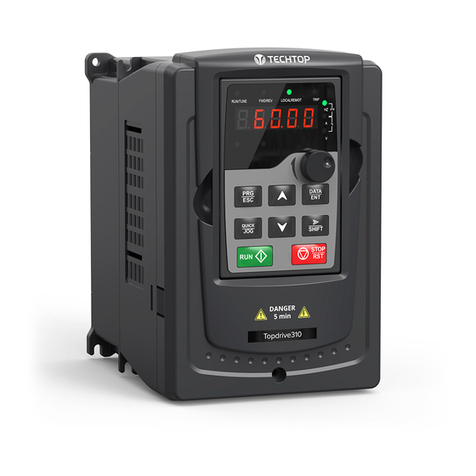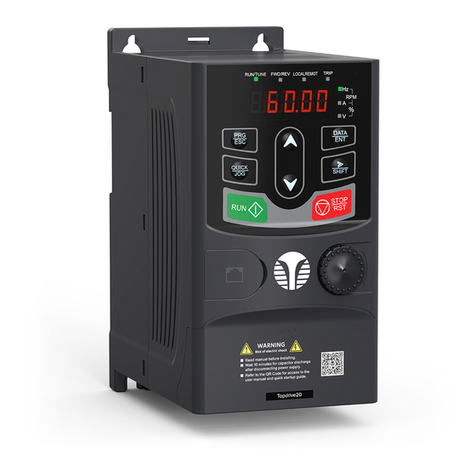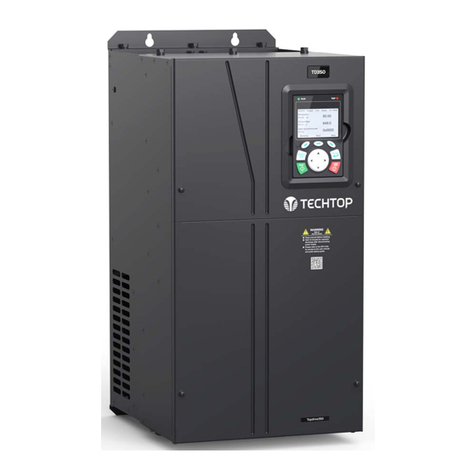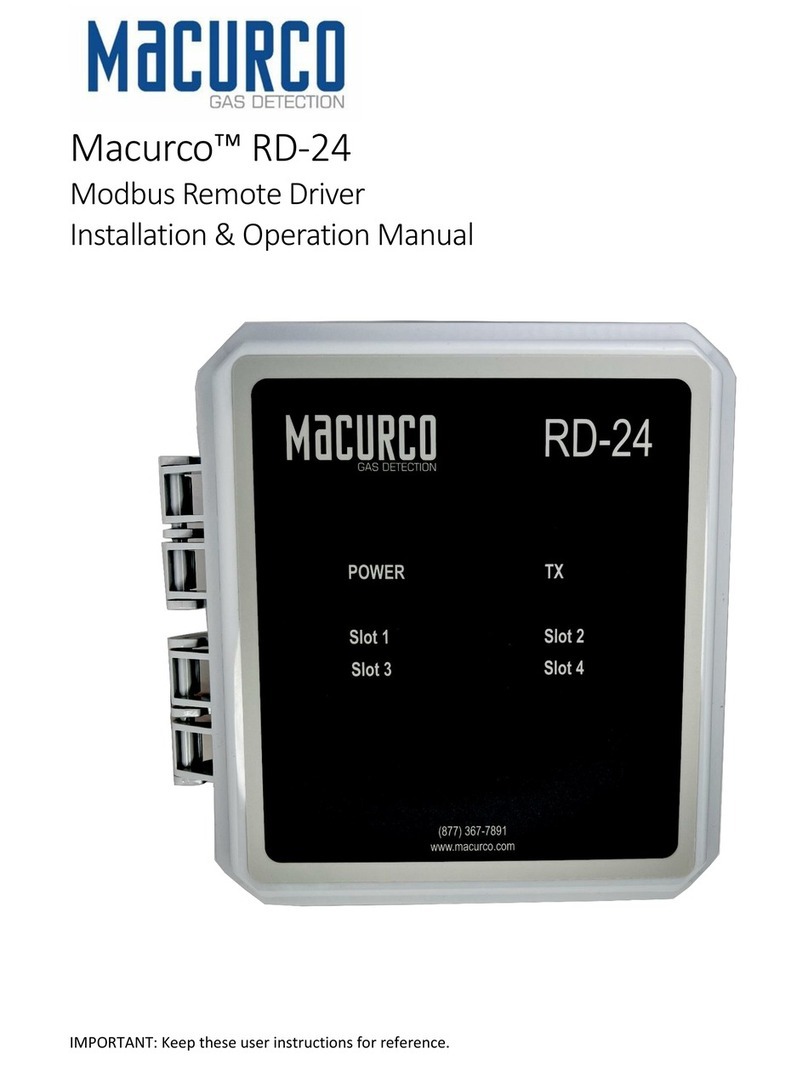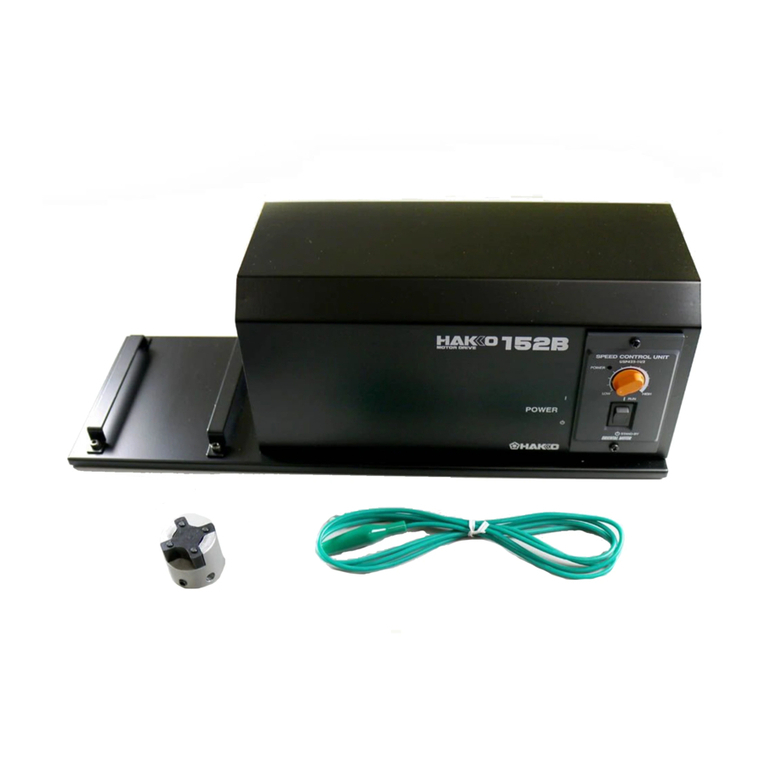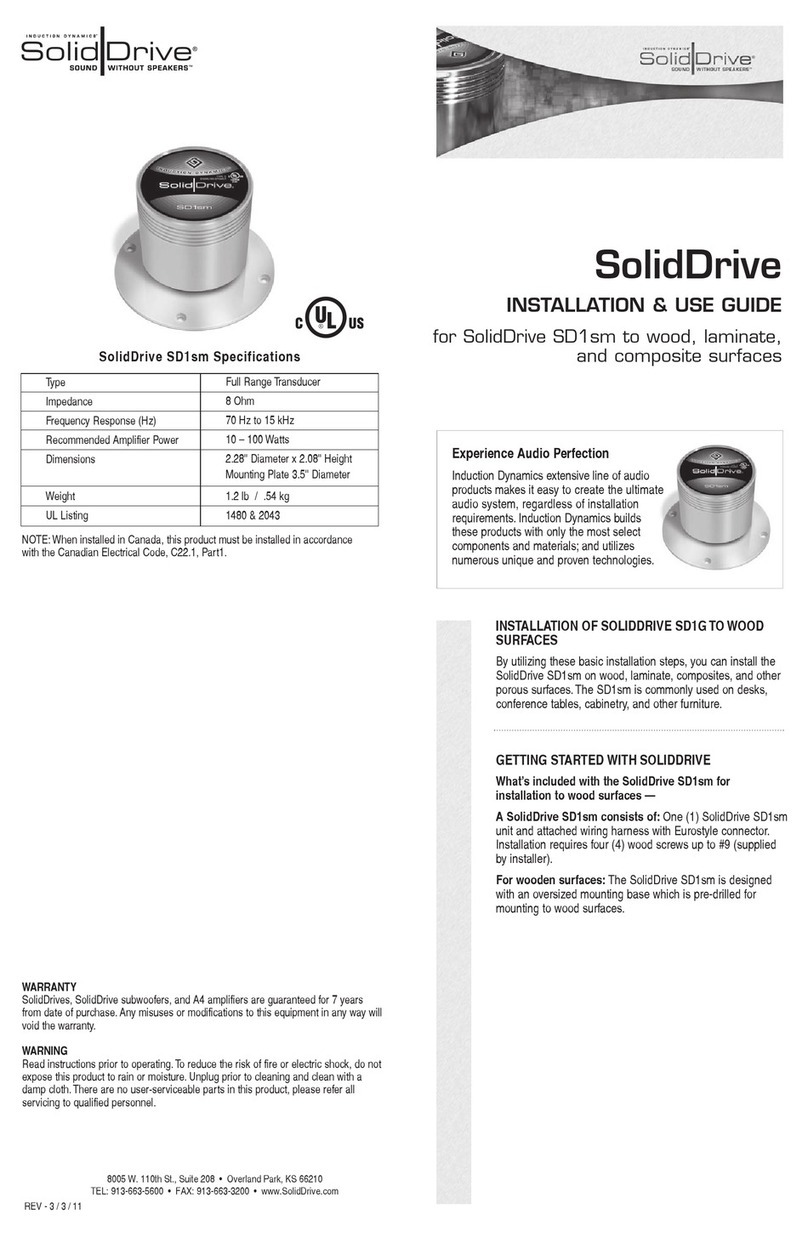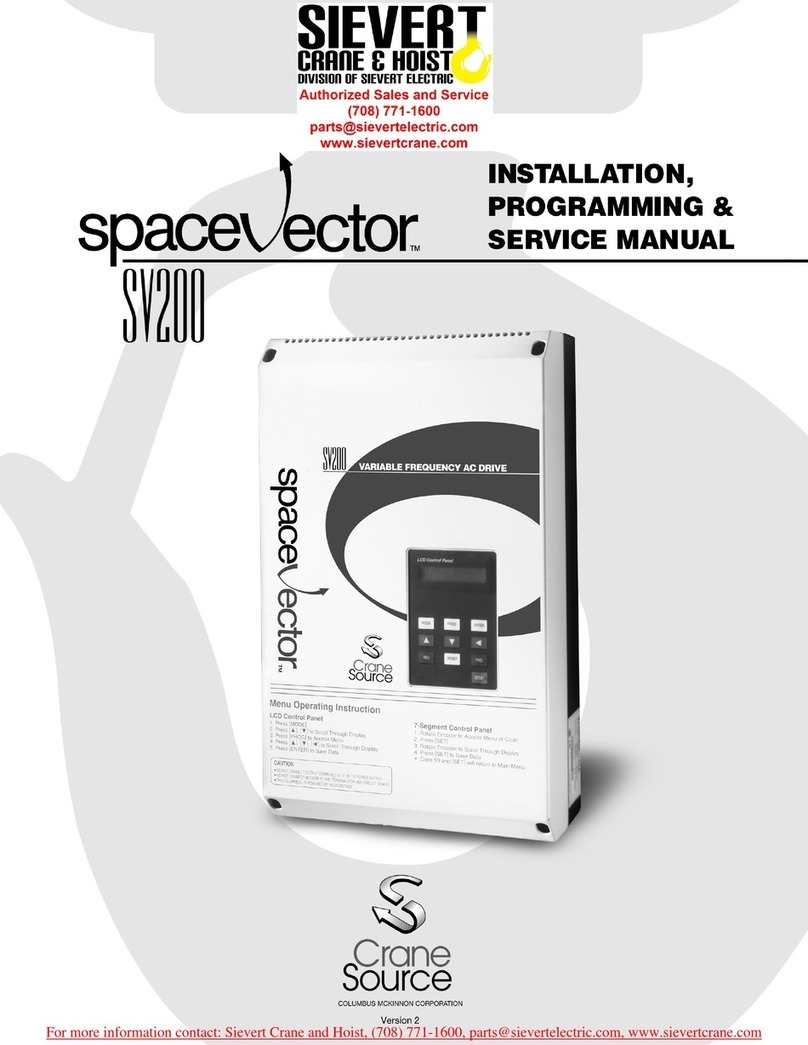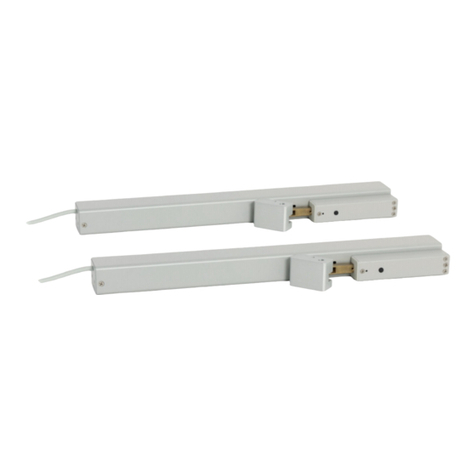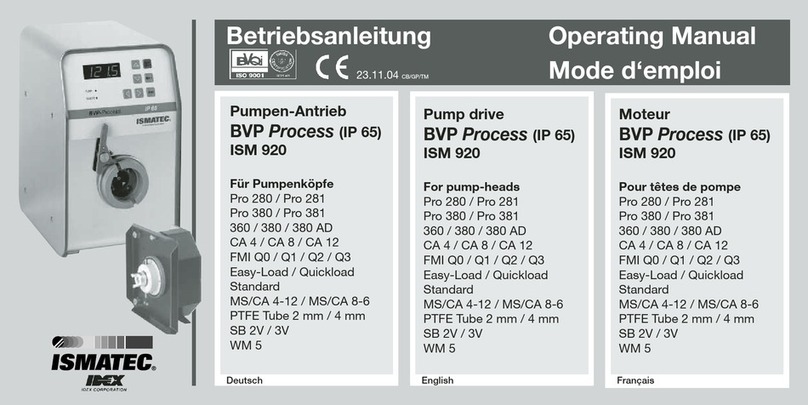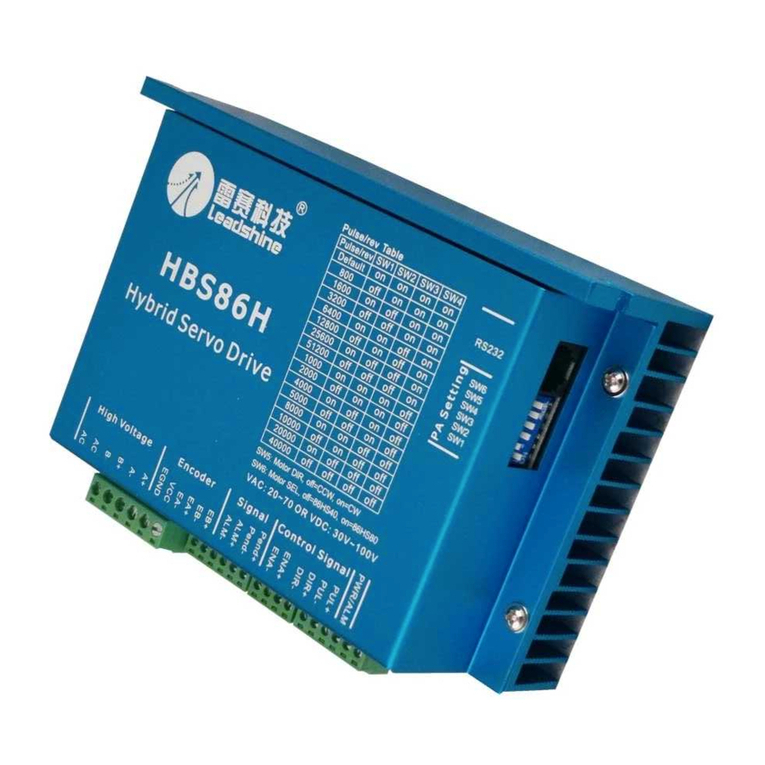TECHTOP TD350 User manual


TD350 Series VFD Preface
i
Preface
Thank you for choosing TD350 series variable-frequency drive (VFD).
TD350 is a high-performance and multi-function VFD aiming to integrate the synchronous motor drive
with asynchronous motor drive, torque control and speed control with position control. It is armed with
advanced vector control technology and the latest digital processor dedicated for motor control, thus
enhancing product reliability and adaptability to the environment. TD350 series VFD adopts
customized and industrialized design to provide excellent control performance through optimized
functions and flexible applications.
In order to meet diversified customer demands, TD350 series VFD provides abundant extension
cards including programmable extension card, PG card, communication card and I/O extension card
to achieve various functions as needed.
The programmable extension card adopts the mainstream development environment for customers
to carry out secondary development easily, fulfilling varied customized needs and reducing customer
cost.
PG card supports a variety of encoders like incremental encoders and resolver-type encoders, in
addition, it also supports pulse reference and frequency-division output. PG card adopts digital filter
technology to improve EMC performance and to realize stable transmission of the encoder signal
over a long distance. It is equipped with encoder offline detection function to contain the impact of
system faults.
TD350 series VFD supports multiple kinds of popular communication modes to provide complicated
system solutions. It can be connected to the internet with optional wireless communication card, by
which users can monitor the VFD state anywhere and anytime via mobile APP.
TD350 series VFD uses high power density design. Some power ranges carry built-in DC reactor and
brake unit to save installation space. Through overall EMC design, it can satisfythe low noise and low
electromagnetic interference requirements to cope with challenging grid, temperature, humidity and
dust conditions, thus greatly improving product reliability.
This operation manual presents installation wiring, parameter setting, fault diagnosis and trouble
shooting, and precautions related to daily maintenance. Read through this manual carefully before
installation to ensure that the TD350 series VFD is installed and operated in a proper manner to give
full play to its excellent performance and powerful functions.
If the product is ultimately used for military affairs or manufacture of weapon, it will be listed on the
export control formulated by Foreign Trade Law of the People's Republic of China. Rigorous review
and necessary export formalities are needed when exported.
Our company reserves the right to update the information of our products.

TD350 Series VFD Contents
ii
Contents
Preface............................................................................................................................................i
Contents.........................................................................................................................................ii
Chapter 1 Safety precautions........................................................................................................1
1.1 What this chapter contains ...............................................................................................1
1.2 Safety definition................................................................................................................1
1.3 Warning symbols..............................................................................................................1
1.4 Safety guidelines..............................................................................................................2
Chapter 2 Quick start.....................................................................................................................5
2.1 What this chapter contains ...............................................................................................5
2.2 Unpacking inspection.......................................................................................................5
2.3 Application confirmation....................................................................................................5
2.4 Environment confirmation.................................................................................................5
2.5 Installation confirmation....................................................................................................6
2.6 Basic commissioning........................................................................................................6
Chapter 3 Product overview..........................................................................................................8
3.1 What this chapter contains ...............................................................................................8
3.2 Basic principle..................................................................................................................8
3.3 Product specification........................................................................................................9
3.4 Product nameplate.........................................................................................................12
3.5 Model code ....................................................................................................................12
3.6 Rated specifications.......................................................................................................13
3.7 Structure diagram...........................................................................................................16
Chapter 4 Installation guidelines ................................................................................................17
4.1 What this chapter contains .............................................................................................17
4.2 Mechanical installation ...................................................................................................17
4.3 Standard wiring of main circuit........................................................................................23
4.4 Standard wiring of control circuit.....................................................................................30
4.5 Wiring protection............................................................................................................33
Chapter 5 Basic operation instructions......................................................................................35
5.1 What this chapter contains .............................................................................................35
5.2 Keypad introduction........................................................................................................35
5.3 Keypad display...............................................................................................................39
5.4 Keypad operation...........................................................................................................41
5.5 Basic operation instruction..............................................................................................53
Chapter 6 Function parameter list ............................................................................................130
6.1 What this chapter contains ...........................................................................................130
6.2 Function parameter list.................................................................................................130
Chapter 7 Troubleshooting........................................................................................................239
7.1 What this chapter contains ...........................................................................................239

TD350 Series VFD Contents
iii
7.2 Indications of alarms and faults ....................................................................................239
7.3 Fault reset....................................................................................................................239
7.4 Fault history .................................................................................................................239
7.5 VFD faults and solutions...............................................................................................239
7.6 Analysis on common faults...........................................................................................248
7.7 Countermeasures on common interference ..................................................................255
Chapter 8 Maintenance and hardware fault diagnosis.............................................................259
8.1 What this chapter contains ...........................................................................................259
8.2 Periodical inspection ....................................................................................................259
8.3 Cooling fan...................................................................................................................261
8.4 Capacitor .....................................................................................................................262
8.5 Power cable.................................................................................................................264
Chapter 9 Communication protocol..........................................................................................265
9.1 What this chapter contains ...........................................................................................265
9.2 Modbus protocol introduction........................................................................................265
9.3 Application of Modbus ..................................................................................................265
9.4 RTU command code and communication data..............................................................271
9.5 Common communication faults.....................................................................................287
Appendix A Extension cards.....................................................................................................288
A.1 Model definition............................................................................................................288
A.2 Dimensions and installation..........................................................................................295
A.3 Wiring..........................................................................................................................298
A.4 IO extension card (EC-IO501-00) function description..................................................298
A.5 Programmable extension card (EC-PC502-00) function description..............................300
A.6 Communication card function description.....................................................................303
A.7 PG extension card function description ........................................................................313
Appendix B Technical data........................................................................................................330
B.1 What this chapter contains...........................................................................................330
B.2 Derated application......................................................................................................330
B.3 Grid specifications........................................................................................................332
B.4 Motor connection data..................................................................................................332
B.5 Application standards...................................................................................................332
B.6 EMC regulations..........................................................................................................333
Appendix C Dimension drawings..............................................................................................335
C.1 What this chapter contains...........................................................................................335
C.2 Keypad structure .........................................................................................................335
C.3 VFD structure ..............................................................................................................336
C.4 Dimensions of VFDs of AC 3PH 200V–240V and 380V–480V......................................336
C.5 Dimensions of VFDs of AC 3PH 520V–600V................................................................342
Appendix D Optional peripheral accessories...........................................................................344
D.1 What this chapter contains...........................................................................................344

TD350 Series VFD Contents
iv
D.2 Wiring of peripheral accessories ..................................................................................344
D.3 Power supply...............................................................................................................345
D.4 Cables.........................................................................................................................345
D.5 Breaker and electromagnetic contactor........................................................................350
D.6 Reactors......................................................................................................................352
D.7 Filters..........................................................................................................................355
D.8 Brake system...............................................................................................................358
Appendix E STO function description ......................................................................................362
E.1 STO function logic table...............................................................................................362
E.2 STO channel delay description.....................................................................................362
E.3 STO function installation checklist................................................................................363
Appendix F Acronyms and abbreviations ................................................................................364
Appendix G Further information...............................................................................................365
G.1 Product and service queries ........................................................................................365
G.2 Feedback on TECHTOP VFD manuals........................................................................365

TD350 Series VFD Safety precautions
-1-
Chapter 1 Safety precautions
1.1 What this chapter contains
Read this manual carefully and follow all safety precautions before moving, installing, operating and
servicing the variable-frequency drive (VFD). If these safety precautions are ignored, physical injury,
death, or damage may occur to the equipment.
If any physical injury or death or damage to the equipment occur due to neglecting the safety
precautions in the manual, our company will not be responsible for any damages and we are not
legally bound in any manner.
1.2 Safety definition
Danger: Serious physical injury or even death may occur if related requirements are not followed.
Warning: Physical injury or damage to the equipment may occur if related requirements are not
followed.
Note: Procedures taken to ensure proper operation.
Qualified electricians: People working on the device should take part in professional electrical and
safety training, receive the certification and be familiar with all steps and requirements of installing,
commissioning, operating and maintaining the device to prevent any emergencies.
1.3 Warning symbols
Warnings caution you about conditions which can result in serious injury or death and/or equipment
damage, and advice on how to avoid the danger. Following warning symbols are used in this manual.
Symbols
Name
Instruction
Abbreviation
Danger
Danger
Serious physical injury or even death
may occur if related requirements
are not followed
Warning
Warning
Physical injury or damage to the
equipment may occur if related
requirements are not followed
Forbid
Electrostatic
discharge
Damage to the PCBA board may
occur if related requirements are not
followed
Hot
Hot sides
The base of the VFD may become
hot. Do not touch.
Electric
shock
As high voltage still presents in the
bus capacitor after power off, wait for
at least five minutes (or 15 min / 25
min, depending on the warning
symbols on the machine) after power
off to prevent electric shock

TD350 Series VFD Safety precautions
-2-
Symbols
Name
Instruction
Abbreviation
Read
manual
Read the operation manual before
operating on the equipment
Note
Note
Procedures taken to ensure proper
operation
Note
1.4 Safety guidelines
Only trained and qualified electricians are allowed to carry out related
operations.
Do not perform wiring, inspection or component replacement when power
supply is applied. Ensure all the input power supplies are disconnected before
wiring and inspection, and wait for at least the time designated on the VFD or
until the DC bus voltage is less than 36V. The minimum waiting time is listed in
the table below.
VFD model
Min. waiting time
220V
0.75–55kW
5 minutes
460V
1.5kW-110kW
5 minutes
132–315kW
15 minutes
350–500kW
25 minutes
575V
0.75kW-110kW
5 minutes
Note: Unless otherwise specified, the "**kW" described in this manual refers to
the power of the HD (CT) models. For VFDs of 75, 132, and 500 kW, HD (CT)
and ND (VT) models must be distinguished.
Do not refit the VFD unless authorized; otherwise, fire, electric shock or other
injuries may occur.
The base of the radiator may become hot during running. Do not touch to avoid
serious injury.
The electrical parts and components inside the VFD are electrostatic. Take
measures to prevent electrostatic discharge during related operation.
1.4.1 Delivery and installation
Install the VFD on fire-retardant material and keep the VFD away from
combustible materials.
Connect the optional brake parts (brake resistors, brake units or feedback
units) according to the wiring diagram.
Do not operate on a damaged or incomplete VFD.
Do not touch the VFD with wet items or body parts; otherwise, electric shock
may occur.
Solid State motor overload protection reacts when reaches 150% of FLA.

TD350 Series VFD Safety precautions
-3-
Note:
Select appropriate tools for delivery and installation to ensure a safe and proper running of the
VFD and avoid physical injury or death. To ensure physical safety, the installation staff should
take mechanical protective measures and wear proper personal protective equipment (PPE).
Ensure to avoid physical shock or vibration during delivery and installation.
Do not carry the VFD by its front cover only as the cover may fall off.
Installation site should be away from children and other public places.
The VFD cannot meet the requirements of low voltage protection in IEC61800-5-1 if the altitude
of installation site is above 2000m.
The VFD should be used in proper environment (see Section 4.2.1 "Installation environment" for
details).
Prevent the screws, cables and other conductive parts from falling into the VFD,
As leakage current of the VFD during running may exceed 3.5mA, ground properly and ensure
the grounding resistance is less than 10Ω. The conductivity of PE grounding conductor is the
same with that of the phase conductor (with the same cross sectional area). For models higher
than 30 kW, the cross sectional area of the PE grounding conductor can be slightly less than the
recommended area.
R, S and T are the power input terminals, and U, V and W are output motor terminals. Connect
the input power cables and motor cables properly; otherwise, damage to the VFD may occur.
1.4.2 Commissioning and running
Disconnect all power sources applied to the VFD before terminal wiring, and wait
for at least the time designated on the VFD after disconnecting the power
sources.
High voltage presents inside the VFD during running. Do not carry out any
operation on the VFD during running except for keypad setting. For products at
voltage levels of 6, the control terminals form extra-low voltage circuits.
Therefore, you need to prevent the control terminals from connecting to
accessible terminals of other devices.
The VFD may start up by itself when P01.21 (restart after power down) is set to 1.
Do not get close to the VFD and motor.
The VFD cannot be used as "Emergency-stop device".
The VFD cannot act as an emergency brake for the motor; it is a must to install
mechanical brake device.
During driving permanent magnet synchronous motor, besides above-mentioned
items, the following work must be done before installation and maintenance.
1. Disconnect all the input power sources including main power and control
power.
2. Ensure the permanent-magnet synchronous motor has been stopped, and
the voltage on output end of the VFD is lower than 36V.

TD350 Series VFD Safety precautions
-4-
3. After the permanent-magnet synchronous motor is stopped, wait for at least
the time designated on the VFD, and ensure the voltage between "+" and "-"
is lower than 36V.
4. During operation, it is a must to ensure the permanent-magnet synchronous
motor cannot run again by the action of an external load; it is recommended
to install effective external brake device or disconnect the direct electrical
connection between permanent-magnet synchronous motor and the VFD.
Note:
Do not switch on or switch off input power sources of the VFD frequently;
For VFDs that have been stored for a long time, set the capacitance and carry out inspection and
pilot run on the VFD before use.
Close the front cover before running; otherwise, electric shock may occur.
1.4.3 Maintenance and component replacement
Only well-trained and qualified professionals are allowed to perform
maintenance, inspection, and component replacement on the VFD.
Disconnect all the power sources applied to the VFD before terminal wiring,
and wait for at least the time designated on the VFD after disconnecting the
power sources.
Take measures to prevent screws, cables and other conductive matters from
falling into the VFD during maintenance and component replacement.
Note:
Use proper torque to tighten the screws.
Keep the VFD and its parts and components away from combustible materials during
maintenance and component replacement.
Do not carry out insulation voltage-endurance test on the VFD, or measure the control circuits of
the VFD with megameter.
Take proper anti-static measures on the VFD and its internal parts during maintenance and
component replacement.
1.4.4 What to do after Scrapping
The heavy metals inside the VFD should be treated as industrial effluent.
When the life cycle ends, the product should enter the recycling system.
Dispose of it separately at an appropriate collection point instead of placing it in
the normal waste stream.

TD350 Series VFD Quick start
-5-
Chapter 2 Quick start
2.1 What this chapter contains
This chapter introduces the basic principles required during installation commissioning. Users can
realize quick installation commissioning by following these principles.
2.2 Unpacking inspection
Check as follows after receiving products.
1. Check whether the packing box is damaged or dampened. If yes, contact local dealers or
TECHTOP offices.
2. Check the model identifier on the exterior surface of the packing box is consistent with the
purchased model. If no, contact local dealers or TECHTOP offices.
3. Check whether the interior surface of packing box is improper, for example, in wet
condition, or whether the enclosure of the VFD is damaged or cracked. If yes, contact local
dealers or TECHTOP offices.
4. Check whether the nameplate of the VFD is consistent with the model identifier on the
exterior surface of the packing box. If not, contact local dealers or TECHTOP offices.
5. Check whether the accessories (including user's manual, control keypad and extension
card units) inside the packing box are complete. If not, contact local dealers or TECHTOP
offices.
2.3 Application confirmation
Check the following items before operating on the VFD.
1. Verify the load mechanical type to be driven by the VFD, and check whether overload
occurred to the VFD during actual application, or whether the VFD power class needs to be
enlarged.
2. Check whether the actual running current of load motor is less than rated VFD current.
3. Check whether the control precision required by actual load is the same with the control
precision provided by the VFD.
4. Check whether the grid voltage is consistent with rated VFD voltage.
5. Check whether the functions required need an optional extension card to be realized.
2.4 Environment confirmation
Check the following items before use.
1. Check whether the ambient temperature of the VFD during actual application exceeds
40°C, if yes, derate 1% for every additional 1°C (for details, see Section B.2.2 "Derating").
In addition, do not use the VFD when the ambient temperature exceeds 50°C.
Note: For cabinet-type VFD, its ambient temperature is the air temperature inside the
cabinet.

TD350 Series VFD Quick start
-6-
2. Check whether ambient temperature of the VFD during actual application is below -10°C, if
yes, install heating facility.
Note: For cabinet-type VFD, its ambient temperature is the air temperature inside the
cabinet.
3. Check whether the altitude of the application site exceeds 1000m, if yes, derate 1% for
every additional 100 m.
4. Check whether the humidity of application site exceeds 90%, if yes, check whether
condensation occurred, if condensation does exist, take additional protective measures.
5. Check whether there is direct sunlight or animal intrusion in the application site, if yes, take
additional protective measures.
6. Check whether there is dust, explosive or combustible gases in the application site, if yes,
take additional protective measures.
2.5 Installation confirmation
After the VFD is installed properly, check the installation condition of the VFD.
1. Check whether the input power cable and current-carrying capacity of the motor cable fulfill
actual load requirements.
2. Check whether peripheral accessories (including input reactors, input filters, output
reactors, output filters, DC reactors, brake units and brake resistors) of the VFD are of
correct type and installed properly; check whether the installation cables fulfill requirements
on current-carrying capacity.
3. Check whether the VFD is installed on fire-retardant materials; check whether the hot parts
(reactors, brake resistors, etc.) are kept away from combustible materials.
4. Check whether all the control cables are routed separately with power cables based on
EMC requirement.
5. Check whether all the grounding systems are grounded properly according to VFD
requirements.
6. Check whether installation spacing of the VFD complies with the requirements in operation
manual.
7. Check whether installation mode of the VFD complies with the requirements in operation
manual. Vertical installation should be adopted whenever possible.
8. Check whether external connecting terminals of the VFD are firm and tight enough, and
whether the moment is up to the requirement.
9. Check whether there are redundant screws, cables or other conductive objects inside the
VFD, if yes, take them out.
2.6 Basic commissioning
Carry out basic commissioning according to the following procedures before operating on the VFD.
1. Select motor type, set motor parameters and select VFD control mode according to actual
motor parameters.

TD350 Series VFD Quick start
-7-
2. Whether autotuning is needed? If possible, disconnect the motor load to carry out dynamic
parameter autotuning; if the load cannot be disconnected, perform static autotuning.
3. Adjust the acceleration and deceleration time based on actual working conditions of load.
4. Jogging to carry out device commissioning. Check whether the motor running direction is
consistent with the direction required, if no, it is recommended to change the motor running
direction by exchanging the motor wiring of any two phases.
5. Set all the control parameters, and carry out actual operation.

TD350 Series VFD Product overview
-8-
Chapter 3 Product overview
3.1 What this chapter contains
This chapter mainly introduces the operation principles, product features, layouts, nameplates and
model instructions.
3.2 Basic principle
TD350 series VFD is used to control asynchronous AC induction motor and permanent-magnet
synchronous motor. The figure below shows the main circuit diagram of the VFD. The rectifier
converts 3PHAC voltage into DC voltage, and the capacitor bank of the intermediate circuit stabilizes
the DC voltage. The inverter converts DC voltage into the AC voltage used by AC motor. When the
circuit voltage exceeds the maximum limit value, external brake resistor will be connected to
intermediate DC circuit to consume the feedback energy.
DC reactor (+)
P1
PE PE
Fig 3.1 Main circuit (VFDs of 220V 18.5–55kW; 460V ≥37kW)
(+)
(-)
PB
PEPE
Fig 3.2 Main circuit (VFDs of 220V ≤15kW; 460V ≤30kW)

TD350 Series VFD Product overview
-9-
R
S
T
U
V
W
PE PE
(+)
(-)
PB
Fig 3.3 Simplified main circuit diagram (VFDs of 575V ≤18.5kW)
R
S
T
U
V
W
P1
PE PE
DC reactor (+)
(-)
Fig 3.4 Simplified main circuit diagram (VFDs of 575V ≥22kW)
Note:
1. The VFDs of 220V (18.5–55kW), 460V (≥37kW,), and 575V (≥22kW) supports external DC
reactors and external braking units, but it is necessary to remove the copper tag between P1 and
(+) before connecting. DC reactors and external braking units are optional.
2. The VFDs of 220V (≤15kW), 460V (≤30kW,), and 575V (≤18.5kW) supports external braking
resistors which are optional.
3. The VFDs of 575V supports external DC reactors and external braking units, but it is necessary to
remove the copper tag between P1 and (+) before connecting. DC reactors and external braking
units are optional.
3.3 Product specification
Function description
Specification
Power input
Input voltage (V)
AC 3PH 200V–240V Rated voltage: 220V
AC 3PH 380V–480V Rated voltage: 460V
AC 3PH 520V–600V Rated voltage: 575V
Allowable voltage
fluctuation
-15%–+10%
Input current (A)
See Section 3.6 "Rated specifications".
Input frequency (Hz)
50Hz or 60Hz, allowable range: 47–63Hz

TD350 Series VFD Product overview
-10-
Function description
Specification
Power
output
Output voltage (V)
0–input voltage
Output current (A)
See Section 3.6 "Rated specifications".
Output power (kW)
See Section 3.6 "Rated specifications".
Output frequency (Hz)
0–400Hz
Technical
control
performance
Control mode
V/F(SVPWM) control, Sensorless Vector Control, Vector
Control
Motor type
Asynchronous motor, permanent-magnet synchronous
motor
Speed regulation ratio
Asynchronous motor 1: 200 (SVC); Synchronous motor 1:
20 (SVC) , 1:1000 (VC)
Speed control precision
±0.2% (SVC), ±0.02% (VC)
Speed fluctuation
±0.3% (SVC)
Torque response
<20ms SVC) , <10ms (VC)
Torque control precision
10% (SVC) , 5% (VC)
Starting torque
Asynchronous motor: 0.25Hz/150% (SVC)
Synchronous motor: 2.5 Hz/150% (SVC)
0Hz/200% (VC)
Overload capacity
G type:
150% of the rated current: 1 minute
180% of the rated current: 10 seconds
200% of the rated current: 1 second
P type:
120% of the rated current: 1 minute
150% of the rated current: 10 seconds
180% of the rated current: 1 second
Running
control
performance
Frequency setting
mode
Digital, analog, pulse frequency, multi-step speed
running, simple PLC, PID, Modbus communication,
PROFIBUS communication, etc;
Realize switch-over between the set combination and the
set channel
Automatic voltage
regulation function
Keep the output voltage constant when grid voltage
changes
Fault protection function
Fault protection function
Provide over 30 kinds of fault protection functions:
overcurrent, overvoltage, undervoltage,
over-temperature, phase loss and overload, etc
Speed tracking restart
function
Realize impact-free starting of the motor in rotating
Note: This function is available for 4kW and above
models

TD350 Series VFD Product overview
-11-
Function description
Specification
Peripheral
interface
Terminal analog input
resolution
No more than 20mV
Terminal digital input
resolution
No more than 2ms
Analog input
2 inputs, AI1: 0–10V/0–20mA; AI2: -10–10V
Analog output
1 output, AO1: 0–10V /0–20mA
Digital input
Four regular inputs; max. frequency: 1kHz; internal
impedance: 3.3kΩ
Two high-speed inputs; max. frequency: 50kHz; supports
quadrature encoder input; with speed measurement
function
Digital output
One high-speed pulse output; max. frequency: 50kHz
One Y terminal open collector output
Relay output
Two programmable relay outputs
RO1A NO, RO1B NC, RO1C common port
RO2A NO, RO2B NC, RO2C common port
Contact capacity: 3A/AC250V, 1A/DC30V
Extension interface
Three extension interfaces: SLOT1, SLOT2, SLOT3
Expandable PG card, programmable extension card,
communication card, I/O card, etc
Others
Installation mode
Support wall-mounting, floor-mounting and
flange-mounting
Temperature of running
environment
-10–50°C, derating is required if the ambient temperature
exceeds 40°C. For details about derating, see Section
B.2.2 "Derating".
Protection level
IP20
Pollution level
Level 2
Cooling mode
Air cooling
Brake unit
Built-in for VFDs of 220V (≤15kW), 460V(≤30kW), and
575V (≤18.5kW);
optional for VFDs of 220V (18.5–55kW), 460V(≥37kW),
and 575V (≥22kW)
EMC filter
The VFDs of 460V are configured with built-in C3 filters,
meeting the requirements of IEC61800-3 C2.
Overvoltage category
For input voltage 220-240V: transient surge suppression
shall be installed on the line side of this equipment and
shall be rated 220V (phase to ground), 220V (phase to
phase), suitable for overvoltage categoryⅢ, and shall
provide protection for a rated impulse withstand voltage
peak of 4kV.
For input voltage 323-480V: transient surge suppression
shall be installed on the line side of this equipment and
shall be rated 480V (phase to ground), 480V (phase to

TD350 Series VFD Product overview
-12-
Function description
Specification
phase), suitable for overvoltage category Ⅲ, and shall
provide protection for a rated impulse withstand voltage
peak of 6kV.
For input voltage 323-480V: transient surge suppression
shall be installed on the line side of this equipment and
shall be rated 575V (phase to ground), 575V (phase to
phase), suitable for overvoltage category Ⅲ, and shall
provide protection for a rated impulse withstand voltage
peak of 6kV.
3.4 Product nameplate
Fig 3.5 Product nameplate
Note: This is an example of the nameplate of standard TD350 products. The CE/TUV/IP20 marking
on the top right will be marked according to actual certification conditions.
3.5 Model code
The model code contains product information. You can find the model code on the nameplate and
simple nameplate of the VFD.
TD350-045G-4
①②③
Fig 3.6 Model code
Field
Sign
Description
Contents
Abbreviation
of product
series
①
Abbreviation of
product series
TD350 is short for Topdrive350 series.
Rated power
②
Power range +
load type
045: 45 kW
G: Constant torque load

TD350 Series VFD Product overview
-13-
Field
Sign
Description
Contents
Voltage level
③
Voltage level
2: AC 3PH 200V–240V
Rated voltage: 220V
4: AC 3PH 380V–480V
Rated voltage: 460V
6: AC 3PH 520V–600V
Rated voltage: 575V
*Note: Most 460V models will show HD - Constant Torque (CT) load and ND - Variable Torque (VT)
load data on nameplate.All drives come factory set for HD.
3.6 Rated specifications
3.6.1 AC 3PH 200V–240V
VFD model
Output power
(kW)
Output
horsepower (HP)
Input
current (A)
Output
current (A)
TD350-0R7G-2
0.75
1
5
4.5
TD350-1R5G-2
1.5
2
7.7
7
TD350-2R2G-2
2.2
3
11
10
TD350-004G-2
4
5
17
16
TD350-5R5G-2
5.5
7.5
21
20
TD350-7R5G-2
7.5
10
31
30
TD350-011G-2
11
15
43
42
TD350-015G-2
15
20
56
55
TD350-018G-2
18.5
25
71
70
TD350-022G-2
22
30
81
80
TD350-030G-2
30
40
112
110
TD350-037G-2
37
50
132
130
TD350-045G-2
45
60
163
160
TD350-055G-2
55
75
200
200
Note:
The input current of 0.75–55 kW VFDs is measured at the input voltage of 220V without reactors.
The rated output current is the output current measured at the output voltage of 220V.
Within the allowable input voltage range, the output current/power cannot exceed the rated output
current/power.
Unless otherwise specified, the "**kW" described in this manual refers to the power of the HD (CT)
models. For VFDs of 75, 132, and 500 kW, HD (CT) and ND (VT) models must be distinguished.

TD350 Series VFD Product overview
-14-
3.6.2 AC 3PH 380V–480V
VFD model
Output
power (kW)
Output
horsepower (HP)
Input current (A)
Output current (A)
HD (CT)
ND (VT)
HD (CT)
ND (VT)
TD350-1R5G-4
1.5
2
5
/
3.7
/
TD350-2R2G-4
2.2
3
5.8
/
5
/
TD350-004G-4
4
5
13.5
19.5
9.5
14
TD350-5R5G-4
5.5
7.5
19.5
25
14
18.5
TD350-7R5G-4
7.5
10
25
32
18.5
25
TD350-011G-4
11
15
32
40
25
32
TD350-015G-4
15
20
40
47
32
38
TD350-018G-4
18.5
25
47
56
38
45
TD350-022G-4
22
30
56
70
45
60
TD350-030G-4
30
40
70
80
60
75
TD350-037G-4
37
50
80
94
75
92
TD350-045G-4
45
60
94
128
92
115
TD350-055G-4
55
75
128
/
115
/
TD350-075P-4
75
100
160
160
150
150
TD350-075G-4
75
100
160
190
150
180
TD350-090G-4
90
125
190
225
180
215
TD350-110G-4
110
150
225
/
215
/
TD350-132P-4
132
175
/
265
/
260
TD350-132G-4
132
175
265
310
260
305
TD350-160G-4
160
215
310
345
305
340
TD350-185G-4
185
250
345
385
340
380
TD350-200G-4
200
270
385
430
380
425
TD350-220G-4
220
300
430
485
425
480
TD350-250G-4
250
340
485
545
480
530
TD350-280G-4
280
375
545
610
530
600
TD350-315G-4
315
425
610
625
600
650
TD350-350G-4
350
465
625
715
650
720
TD350-400G-4
400
535
715
/
720
/
TD350-500P-4
500
670
/
890
/
860
TD350-500G-4
500
670
890
/
860
/
Note:
The input current of 1.5–200kW VFDs is measured at the input voltage of 460V without reactors.
The input current of 220–500kW VFDs is measured at the input voltage of 460V with reactors.
The rated output current is the output current measured at the output voltage of 460V.
Within the allowable input voltage range, the output current/power cannot exceed the rated
output current/power.
Unless otherwise specified, the "**kW" described in this manual refers to the power of the HD (CT)
models. For VFDs of 75, 132, and 500 kW, HD (CT) and ND (VT) models must be distinguished.

TD350 Series VFD Product overview
-15-
3.6.3 AC 3PH 520V–600V
VFD model
Output power
(kW)
Output
horsepower
(HP)
Input current
(A)
Output current
(A)
TD350-0R7G-6
0.75
1
3.3
2.1
TD350-1R5G-6
1.5
2
5
3.2
TD350-2R2G-6
2.2
3
7
4.5
TD350-004G-6
4
5
10
6.5
TD350-5R5G-6
5.5
7.5
13
9
TD350-7R5G-6
7.5
10
16.5
12
TD350-011G-6
11
15
19
16
TD350-015G-6
15
20
24
21
TD350-018G-6
18.5
25
29
27
TD350-022G-6
22
30
40
35
TD350-030G-6
30
40
47
45
TD350-037G-6
37
50
52
52
TD350-045G-6
45
60
65
62
TD350-055G-6
55
75
85
86
TD350-075G-6
75
100
95
98
TD350-090G-6
90
125
118
120
TD350-110G-6
110
150
145
150
Note:
The input current of 0.75–110kW VFDs is measured at the input voltage of 575V without
reactors.
The rated output current is the output current measured at the output voltage of 575V.
Within the allowable input voltage range, the output current/power cannot exceed the rated
output current/power.
Unless otherwise specified, the "**kW" described in this manual refers to the power of the HD
(CT) models. For VFDs of 75, 132, and 500 kW, HD (CT) and ND (VT) models must be
distinguished.
This manual suits for next models
2
Table of contents
Other TECHTOP DC Drive manuals
Popular DC Drive manuals by other brands
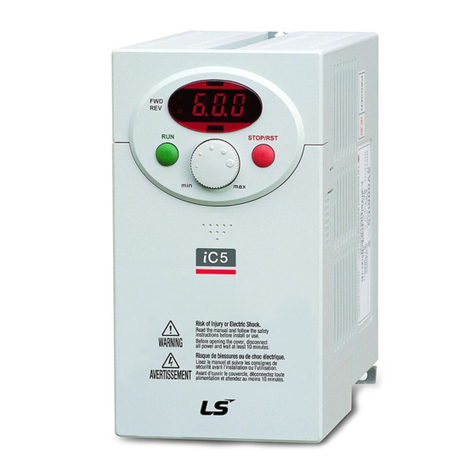
LSIS
LSIS SV008iC5-1F manual

Hubbell
Hubbell Universal Hose Reel-Chain Drive UH28 Installation and maintenance instructions
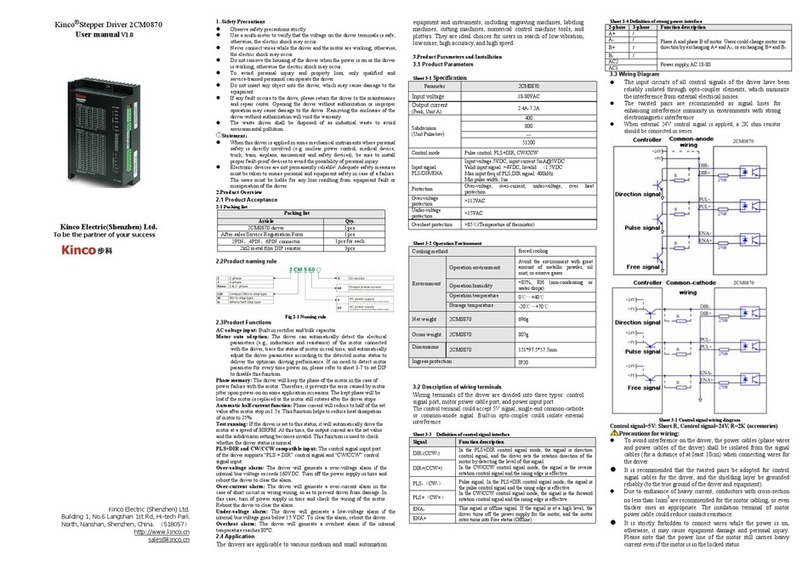
Kinco
Kinco 2CM0870 user manual

GFA
GFA ELEKTROMAT SI 55.10-40,00 installation instructions
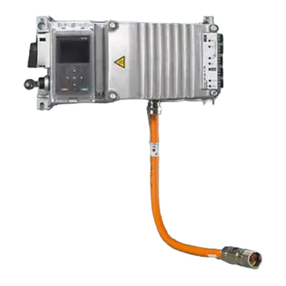
SEW-Eurodrive
SEW-Eurodrive MOVIMOT flexible MMF1 C/DBC Series operating instructions

YASKAWA
YASKAWA V1000 MMD quick start guide
